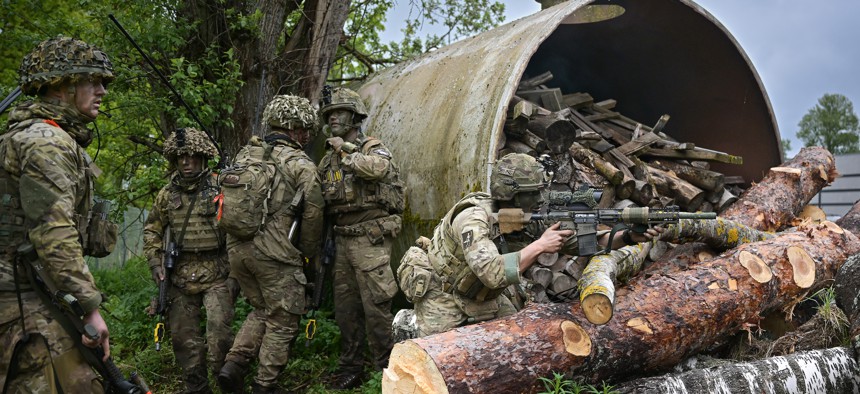
Soldiers from Royal Welsh Battlegroup take part in maneuvers during NATO exercise Hedgehog on the Estonian Latvian border on May 26, 2022 in Voru, Estonia. Getty Images / Jeff J. Mitchell
‘Obsolete’ NATO Force Presence in Baltics Needs Upgrade, Estonian Defense Leader Says
“It’s a joke” that Russia would be deterred by a battalion, secretary says.
NATO must station more forces in the Baltic nations to provide a more credible deterrent after Russia’s invasion of Ukraine, the Estonian defense secretary said Wednesday.
Kusti Salm, the permanent secretary of the Estonian Ministry of Defense, said the number of NATO troops in Estonia, Lithuania, Latvia today, which is intended to act as a “tripwire” for Russian aggression, is too small to deter Russian aggression or quickly push back troops from Moscow. In the time it would take for a large enough NATO force to respond, Russia would have already destroyed cities and killed civilians, leaving the alliance with the tougher task of liberating land rather than defending it in the first place, Salm said.
“The current NATO strategy of tripwire defense or deterrence by punishment…is clearly politically obsolete,” he said at a Center for Strategic and Budgetary Assessments event to roll out a report on Baltic security. “We need to shift from tripwire…to deterrence by denial.”
In 2016, after Russia annexed Crimea, NATO agreed to send rotational battlegroups to Estonia, Latvia, Lithuania, and Poland. When Moscow further invaded Ukraine in February, the alliance established four new battlegroups in Bulgaria, Hungary, Romania, and Slovakia. More than 40,000 NATO troops are on the eastern front of the alliance to deter encroachment from Russia.
In a June 2 report, CSBA analysts argue that NATO should double the troop presence in the Baltics and ensure at least one tank battalion is in each Baltic nation.
But Salm said that’s still not enough.
“It would be ridiculous to claim that the second largest nuclear nation in the world would somehow be deterred by a battalion. It’s a joke,” he said.
Eastern Europeans have long called for a larger troop presence to fend off growing threats from Russia. In 2018, Poland offered to name one of its military bases after President Donald Trump to get thousands more American troops permanently stationed in the country. In August, Lithuania unveiled a brand-new 7-million-euro base just 10 miles from the Belarussian border to try to get Washington to make its rotational deployment permanent.
The Pentagon released its force posture review in November, which made modest changes in Europe, but prioritized troop presence in the Indo-Pacific.
Leaders from NATO members will meet in Madrid in two weeks to set the alliance’s priorities for the next decade, and what the force posture in Eastern Europe should be is expected to be an important topic of discussion.
The CSBA report also made several other recommendations for NATO, as well as specific suggestions for Estonia and the other Baltic countries. NATO should “clarify and strengthen” the command structure in the Baltics, including establishing an operational headquarters in the region. The alliance should also preposition stocks of munitions like Javelins and Stingers in the region, increase NATO air and missile defense capabilities in the Baltics, and share more intelligence with allies like Lithuania, Estonia, and Latvia.
The report recommended that Estonia build and expand training facilities to offer unique opportunities to encourage more NATO troops to rotate through the country. It also recommended that all Baltic nations increase defense spending to at least 3 percent of GDP, up from a target of 2.5 percent set by the countries, and to work with each other on an integrated regional defense plan.





